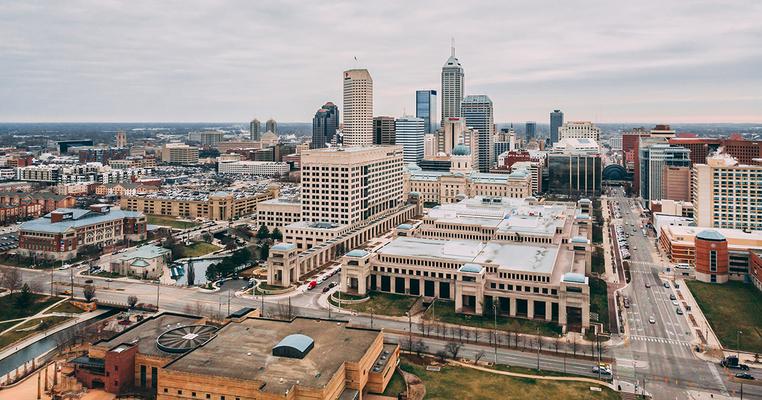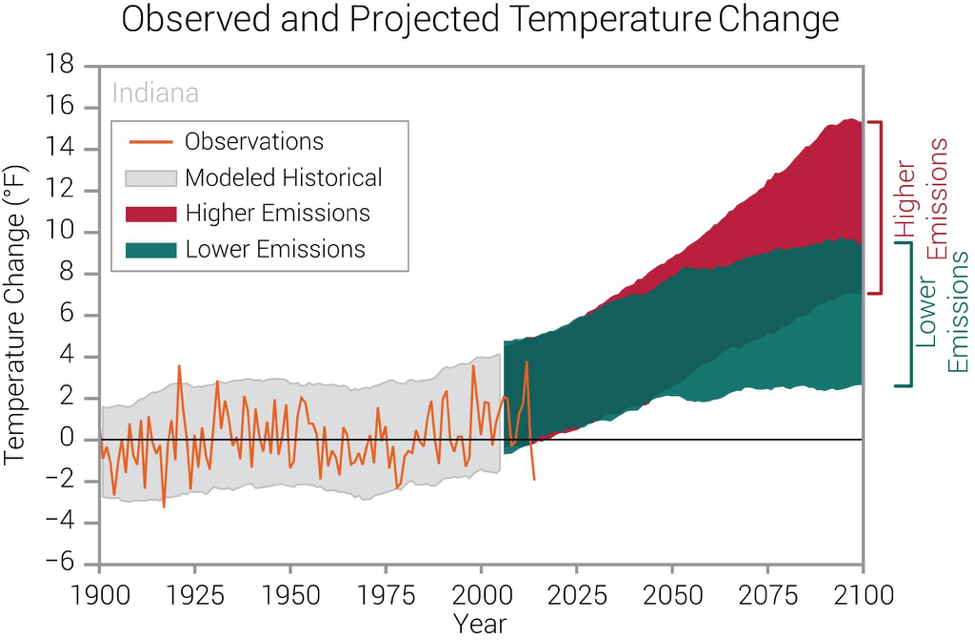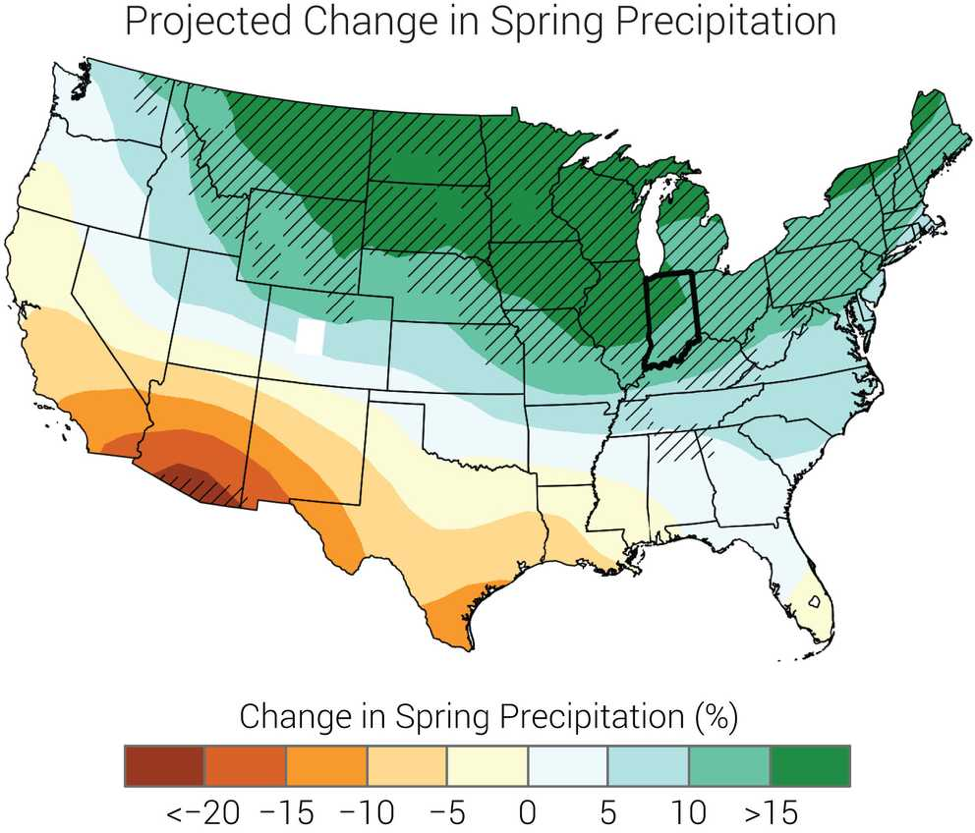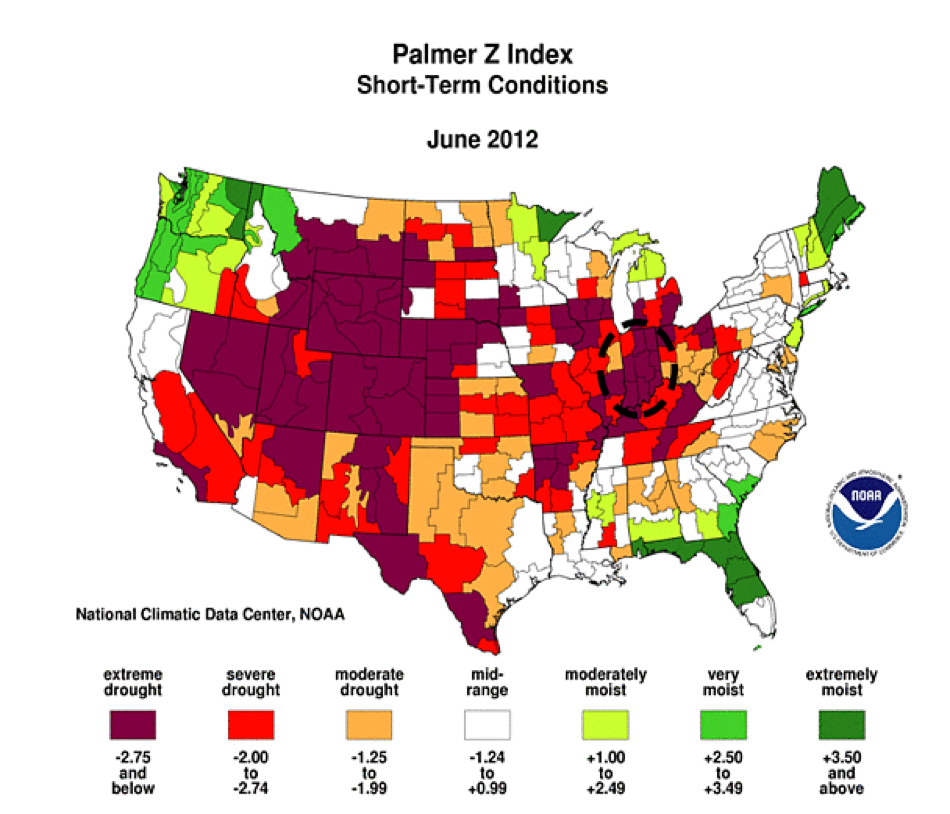
How Is Climate Change Affecting Indiana?
Indiana is a Midwestern state that’s earned a corny reputation, producing hundreds of millions of pounds of maize every year. You’ve probably seen A Christmas Story, Parks and Recreation, or Stranger Things — all three are set somewhere in Indiana.
And people who call the state home are often called Hoosiers, though nobody seems to quite agree on why.
Today, Hoosiers are already seeing the impacts of climate change at home — from rising temperatures and heavy downpours to bigger, badder droughts. Here are the climate realities they face.
Temperature
Here’s the climate reality: Since 1895, Indiana’s average annual temperature has increased by 1.2 degrees Fahrenheit. According to the Indiana Climate Change Impacts Assessment from Purdue University, Hoosiers could see temperatures rise by up to about 6 degrees Fahrenheit by 2050.
Why are average temperatures on the way up in Indiana and around the globe? Well, when humans burn fossil fuels like oil, natural gas, and coal, we release greenhouse gases like carbon dioxide and methane into the atmosphere. These gases trap heat on our planet and cause temperatures around the globe to rise. These higher temperatures disrupt our climate in ways we’re already seeing today.

Observed and project temperature rise in Indiana (courtesy of NOAA)
When scientists look at how much a state or region will warm in the future, they usually map out projections based on higher and lower emissions scenarios (as you can see in the graph above). That’s because what happens in the future is in our hands today. If we take bold climate action and cut our fossil fuel emissions, we will see far less drastic changes in temperature than if we just continue with business as usual.
You might be thinking that a degree or two of temperature rise doesn’t seem like a big deal, but the researchers at Purdue emphasize in their report that “a few degrees of change in these averages translates into serious local impacts.”
One of the most obvious local impacts for Indiana? Big hits to the state’s food crops, which generate $31 billion per year for the state. According to Purdue researchers, warmer temperatures have already reduced corn yields. As temperatures continue to rise, corn yields are expected to fall even more, the researchers report: “More frequent heat stress and a doubling of water deficits are expected to reduce Indiana corn yields, for current varieties, by 16 to 20 percent by mid-century. Soybean yields are expected to decline 9 to 11 percent.” That’s bad news for farmers (and, you know, everyone who eats).
Rising temperatures present a threat to both Indiana’s economy and food security — but the heat itself can also mean real hazards for Hoosiers’ health. Indiana seldom experiences dangerously hot days. But thanks to climate change, “the state is projected to see an average of 39 danger days a year” by 2050. Exposure to extreme heat can overwhelm the human body, especially for people who are already vulnerable (like the elderly, young children, the poor, outdoor workers, and those with pre-existing conditions) — resulting in heat cramps and even heat stroke, which can be fatal.
Heavy Precipitation and Flooding
Here’s the climate reality: Indiana is expected to not only get warmer with climate change. It’s also expected to get wetter overall. Average precipitation has gone up by nearly six inches since 1895 and the state is seeing more and more heavy downpours.
We’re seeing it in Indiana, Wisconsin, Michigan, and across the Midwest: as temperatures rise and the climate changes, precipitation is increasing, too (especially in the winter and spring months).
It’s pretty simple science: When it’s warmer than usual outside, evaporation from land and water increases. Warm air also holds more water vapor, creating the perfect conditions for more intense rain and snowfall.
Drone footage of flooding in #Niles today, via @theChagoFlores pic.twitter.com/NyUfPkHOAd
— South Bend Tribune (@SBTribune) February 21, 2018
To get an idea of what the future may hold for Indiana, we can look back at what happened there in 2018. In February of that year, Indiana saw both a great deal of snowmelt and “record-breaking rainfall” in places like South Bend and Goshen, which “led the Elkhart River to rise to a record 13.2 feet.”

“Projected change in spring precipitation (%) for the middle of the 21st century compared to the late 20th century under a higher emissions pathway.” (Source: NOAA)
For some cities in the region, these were “all-time record-breaking floods.” But the records didn’t stop there: floods and heavy rain made May 2018 to April 2019 the wettest 12-month period on record for the Hoosier State. This heavy precipitation and resultant flooding forced farmers to push back planting their crops, damaged local infrastructure and homes, and in some cases, made drinking water unsafe.
>> Learn more: The Climate Crisis and Flooding <<
Drought
Here’s the climate reality: Like the rest of the Midwest, Indiana is projected to see an increase in precipitation. But when summer droughts do come around, they are likely to be more intense.
How can climate change be linked to both flooding and drought? Because climate change pushes our water cycle into overdrive. We’ve already established that higher temperatures mean more water is evaporating from land into the atmosphere, fueling intense rainstorms and flooding. Much of that water runs off into rivers and streams, leaving the land dry. Together with higher temperatures, this increases drought risk.
During the summer of 2012, much of the United States was in the grips of an epic drought. Indiana was hit hard: in what was later declared the third-driest June on state record, the entire state was classified as in “severe” to “extreme” drought, according to the Central US 2012 Drought Assessment (PDF). Farmers had to replant soybeans because they weren’t growing, pests started to infest crops, and when it came time to harvest, the corn yield was about 38 percent lower than usual.

Palmer-Z drought index of the United States (June 2012, courtesy of NOAA). Indiana is circled.
Farmers in Indiana and around the world depend on a stable climate and reliable precipitation patterns to grow the food we all enjoy. But climate change is wreaking havoc on their livelihood, as well as the food and water security we depend on. Without bold climate action to curb fossil fuel emissions, Indiana could see more extreme droughts like this in the decades to come.
Here’s How to Take Action
That probably felt like a lot of bad news at once, but we're here to tell you this: climate change is real, it is solvable, and the solutions are available today.
One way you can make a difference? By joining us for our first-ever Climate Reality Leadership Corps virtual training. Work with former Vice President Al Gore and incredible experts from across disciplines to learn how you can inspire action for climate solutions in your community and beyond.
As Leslie Knope—arguably one of the most famous (though fictional) Indiana residents—once said of public service on Parks and Recreation, “We do it because we get the chance to work hard at work worth doing. … Now, go find your team and get to work.”
Listen to Leslie: Find your team and do work worth doing. Become a Climate Reality Leader today.

